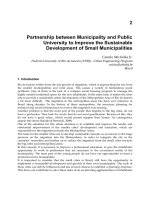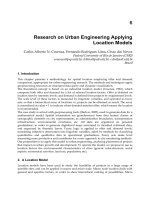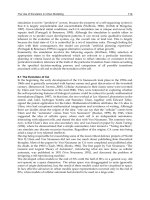Supply chain engineering useful methods and techniques (2010) alexandre dolgui, jean marie proth
Bạn đang xem bản rút gọn của tài liệu. Xem và tải ngay bản đầy đủ của tài liệu tại đây (4.99 MB, 552 trang )
Supply Chain Engineering
Alexandre Dolgui · Jean-Marie Proth
Supply Chain Engineering
Useful Methods and Techniques
123
Prof. Alexandre Dolgui
Ecole des Mines de Saint-Étienne
Centre for Industrial Engineering
and Computer Science
158 cours Fauriel
42023 Saint-Étienne CX 02
France
Jean-Marie Proth
Institut National de Recherche
en Informatique et Automatique
Île du Saulcy
57045 Metz CX 1
France
ISBN 978-1-84996-016-8 e-ISBN 978-1-84996-017-5
DOI 10.1007/978-1-84996-017-5
Springer London Dordrecht Heidelberg New York
British Library Cataloguing in Publication Data
A catalogue record for this book is available from the British Library
Library of Congress Control Number: 2010928838
© Springer-Verlag London Limited 2010
Apart from any fair dealing for the purposes of research or private study, or criticism or review, as
permitted under the Copyright, Designs and Patents Act 1988, this publication may only be
reproduced, stored or transmitted, in any form or by any means, with the prior permission in writing o
f
the publishers, or in the case of reprographic reproduction in accordance with the terms of licences
issued by the Copyright Licensing Agency. Enquiries concerning reproduction outside those terms
should be sent to the publishers.
The use of registered names, trademarks, etc. in this publication does not imply, even in the absence o
f
a specific statement, that such names are exempt from the relevant laws and regulations and therefore
free for general use.
The publisher makes no representation, express or implied, with regard to the accuracy of the
information contained in this book and cannot accept any legal responsibility or liability for any errors
or omissions that may be made.
Cover design: eStudioCalamar, Figueres/Berlin
Printed on acid-free paper
Springer is part of Springer Science+Business Media (www.springer.com)
Université de Metz
Preface
Supply chain engineering is an emerging field based on analysis and comprehen-
sion of the essential principles of production and distribution systems. This scien-
tific domain concerns the methodical evaluation and optimization of production
systems, logistics networks, and their management policies to increase the
effectiveness of multifaceted demand and supply chains.
Worldwide competition has grown ever stronger since the beginning of the
1980s. The pressure of the competitive global market has intensely affected the
production systems, calling for:
• integration of the activities that cover the whole production spectrum from cus-
tomers’ requirements to payment;
• flexibility in the face of customer-demand changes;
• drastic reduction of production costs.
To reach these objectives, radical changes have been introduced in production
systems, thanks to new manufacturing technologies that increase efficiency and IT
technologies that improve system organization and management.
Furthermore, dynamical pricing and revenue management, which proposes ap-
proaches that define the price of the products based on market situations, attracts
more and more researchers and practitioners. Pricing stresses the return on the in-
vestment.
Supply chains are emblematic examples of the renewal of production systems
in recent decades. It is through this new paradigm that cost reduction and service
enhancement can be achieved. To make this easier to implement, new types of
manufacturing systems have been introduced, for example: reconfigurable manu-
facturing systems (RMS), assembly lines with worker’s flexibility, bucket bri-
gades or U-shaped assembly lines. Over the same period, new technologies arose
to monitor the state of systems in real time. We can mention radio-frequency iden-
tification (RFID), Internet applications or “intelligent” storage facilities, to name
just a few. These technologies favor one of the most important objectives of pro-
duction systems management: the ability to make a decision almost immediately.
Radical changes in the criteria that express the new objectives of production
systems in the face of competition are another important aspect. The introduction
of some new criteria reflects the just-in-time (JIT) requirements. For instance,
conventional scheduling optimization is now restricted, in the best case, to decid-
vi Preface
ing the order products are launched in production. In other words, the conven-
tional scheduling activity migrated from the tactical to the strategic level. In actual
production systems, this is replaced by a real-time scheduling, also called real-
time assignment. Other criteria are used to reflect quality, flexibility and work-in-
progress (WIP): adequate quality is now unavoidable to meet customers’ satisfac-
tion; flexibility is a necessary condition to remain competitive in an ever-changing
market; and reduction of WIP is a factor to minimize the production cost and the
probability of obsolescence.
The authors of this book collaborate closely with companies. They have been
charged with numerous contracts covering a wide range of industrial activities, in-
cluding steelmaking, aerospace research, car manufacturing, microelectronics, and
in the machining industry. In these areas, the authors worked on design and man-
agement problems. They reached the following conclusions:
• The difficulty for companies lies much more in determining the exact nature of
a problem and defining the criteria to be taken into account, than in solving the
problem itself.
• The models available in the literature are often difficult to apply in real life, due
to the assumptions that were made in order to have a treatable model.
• To be acceptable to companies, models must be simple, easy to apply and ad-
justable to the systems under study.
These conclusions are also taken into account in this book.
This reference work presents a general view of new methods, techniques, re-
sources and organizations that have erupted in the production domain during the
past two decades. The objective of the authors was to furnish the best applied ap-
proaches. Of course, if a theoretical approach is more convenient to provide the
essentials of the system under study, then it was included. Furthermore, when a
simple and efficient model exists to represent an industrial situation, we discard
more complicated models that do not provide significantly better results, even if
they are widely cited in the literature.
The book is organized into 11 chapters with 5 appendices. The following topics
are covered.
Chapter 1 should be considered as an introduction to pricing. After outlining
the importance of pricing to increase revenue, and providing the most common
definitions in use in the field, pricing strategies are presented. The mechanisms
that link costs, price and margin are analyzed. The selling curve is introduced and
several methods to find the characteristics of importance to customers are devel-
oped. This chapter ends with price strategy in the oligopoly market.
Chapter 2 has as a main goal to introduce stochastic dynamic pricing models
with salvage values. The constraints to apply to make this model manageable are
given. Pricing models for time-dated items, with no supply option, in a monopolis-
tic environment, and with myopic customers are presented in detail.
Chapter 3 concerns outsourcing, which is little studied academically in spite of
its importance in the actual global market place. After defining the main notions,
the most common benefits that may be expected from outsourcing are presented.
Preface vii
The steps that lead to outsourcing are detailed. In particular, a vendor selection
and evaluation model is developed and several approaches to solve this multicrite-
ria problem are proposed. The strategic outsourcing in the case of a duopoly mar-
ket is then developed exhaustively. The arguments of the pro and cons are ex-
plored. One of the original aspects of this chapter lies in the analysis of offshoring
in China. Some arguments in this discussion are quite different from those usually
used in the literature. The reason may be that the effects of offshoring on workers
in developed countries are taken into account.
Chapter 4 considers inventory management in supply chains. The advantages
of sharing information among the different levels of a supply chain are discussed.
Particular attention is given to the bullwhip effect and the actions to be taken in
order to reduce this undesirable phenomenon. Some usual and robust models are
highlighted, such as the newsboy (or newsvendor) model, finite-horizon model
with stochastic demands and the well-known (R, Q) and (s, S) models. For the last
two models, we show how simulation can be used to find the “optimal” values for
their parameters. Echelon stock policies, which are tools that meet supply chain
requirements, are analyzed along with their complimentary tools, such as material
requirements planning (MRP) and manufacturing resources planning (MRP2).
Due to the importance of the subject (mainly at the design level), we also review
the most common lot-sizing models.
Chapter 5 gives a brief description of the RFID (radio-frequency identification)
technology. An analysis of the parameters of importance when selecting tags is
conducted and a succinct guideline for RFID deployment is suggested. Some ap-
plications are reviewed and the importance of this technology for the efficiency of
supply chains is outlined. The main domains where RFID is applied routinely are
listed. The evaluation of this technology, and in particular the financial implica-
tion, is performed. A special section deals with privacy concerns that are an im-
portant problem of RFID in today’s situation. The last section raises the problem
of authentication, which is especially significant for the case of counterfeit tags.
Chapter 6 presents an overview of manufacturing system organizations. This
chapter is influenced by the heavy demands for flexibility and adaptability of
manufacturing systems in the modern environments. The history of the idea of
flexibility is presented and the majority of production system concepts are ana-
lyzed: dedicated manufacturing lines (DML), flexible manufacturing systems
(FMS), agile manufacturing systems (AMS), reconfigurable manufacturing sys-
tems (RMS) and lean manufacturing systems (LMS). Each is defined, its advan-
tages and drawbacks are studied and some illustrative examples are reported.
Comparisons are made among them and their appropriateness to supply chains is
highlighted.
Chapter 7 develops a complex and essential issue (particularly for lean manu-
facturing) of line balancing, which consists in minimizing the total idle time. The
models examined in this chapter have deterministic times. The COMSOAL ap-
proach is analyzed comprehensively along with possible improvements. Other al-
gorithms the most frequently mentioned in the literature, such as RPW, KW-like
heuristic, B&B-based and mathematical programming approaches, are also pre-
viii Preface
sented and illustrated. The use of metaheuristics is shown in the third part of this
chapter. Simulated annealing, tabu search and genetic algorithms are discussed.
Then, the properties and evaluation of line-balancing solutions are underlined. We
also go over the evaluation criteria for line balancing from the literature.
Chapter 8 generalizes assembly-line-balancing models presented in the previ-
ous chapter to stochastic operation times. The problems tackled in this chapter are
examined from a practical point of view. In particular, probabilities are defined as
is usually done in companies, i.e., by three parameters: minimum, most frequent
and maximum values of the variable under consideration. This leads to the notion
of triangular density. Problems are solved numerically. A powerful tool is pro-
posed for computing the integration of functions: Tchebycheff's polynomial ap-
proach. Numerical examples are presented to illustrate these realistic solutions.
Mixed assembly-line models with several types of products are also considered.
Other interesting generalizations, such as line balancing with equipment selection,
are introduced. Finally, the new concepts of dynamical work sharing are explained
using the examples of the bucket brigades and U-shaped assembly lines.
Chapter 9 is devoted to the control reactivity, which is becoming a pivotal fac-
tor for competitiveness. We show that the static scheduling is slowly vanishing
from the industrial environment. It is being replaced by dynamic scheduling and
real-time assignment approaches that are able to provide an optimal or near-
optimal solution in real time. The most popular priority (or dispatching) rules are
presented first, followed by a second type of dynamic scheduling called the “re-
pair-based approach” that consists of computing a static schedule at the beginning
of the working period and adjusting it in the case of unexpected events.
Chapter 10 concerns facility layout design. Until the 1980s, the objective was
to optimize the layouts assuming that the environment remained basically steady.
This situation is referred to as static facility layout (SFL). Linear layouts, func-
tional department layouts and cellular layouts are studied in the first part of this
chapter, as well as tools and algorithms used to perform optimal layout designs. In
the middle of the 1990s, the problem evolved toward dynamic facilities layouts
(DFL) and robust layouts (RL) to meet the needs of enterprises manufacturing
multiple products in a rapidly changing market. Most results in these areas con-
cern only the location of manufacturing entities on the available factory surface at
the design stage. Rapid advances in mechanical engineering and manufacturing
organization may lead to the possibility of real-time rearrangement in the near fu-
ture.
Chapter 11 presents warehousing. Certainly, warehouses are critical compo-
nents of production systems. In this chapter, their usefulness is highlighted and
various functions and equipment are analyzed. Recent advances such as the value-
added services and their corresponding areas are covered. Special attention is paid
to the warehouse management, in particular, to the main difficulties faced by their
managers. The design stage is also extensively considered via developing storage
algorithms for unit-load warehouse as well as examining warehouse sizing static
and dynamic models. The last section of this chapter concerns the location of
warehouses. Single- and multiflow location problems are put forth. Remember
Preface ix
that layout techniques, which also concern warehouses, were presented in Chap-
ter 10.
Five types of optimization techniques are reported and illustrated at the end of
the book in the appendices. Each of the approaches covered in these appendices
has been used in at least one chapter to solve real-life problems:
• The first appendix explains the stimulated annealing method.
• The second is devoted to dynamic programming based on the optimality prin-
ciple.
• The well-known branch-and-bound (B&B) approach is explained in the third.
• The fourth presents tabu search techniques.
• Genetic algorithms are presented in the last appendix.
We had several audiences in mind when this book was written.
In companies, the people in charge of management, production, logistics, sup-
ply chains, and those looking for suggestions to improve the efficiency of their
systems, will be certainly interested in many of the advances covered in this book.
They also will appreciate the way explanations are given by using basic examples,
providing detailed algorithms, while discarding complex and unnecessary theo-
retical developments. This book is written for managers and engineers with ana-
lytical backgrounds, who are interested in capturing the potentials and limits of the
recent advances in production and operations management.
The academic audience consists of the many researchers working in topics re-
lated to operations research, supply chain management, production system design,
facility layout, scheduling, organization, etc. This book will also be useful to pro-
fessors who teach industrial and systems engineering, management science, opera-
tions management as well as business management specifically because of the
carefully chosen examples that are provided and the application oriented approach
in which the notions are introduced.
To summarize, this book is within the comprehension of industrial managers
having an analytical background and eager to improve the efficiency of their com-
pany, as well as researchers and students working in various related areas.
The authors acknowledge Mrs. Marie-Line Barneoud for help in the formatting
of this book and Mr. Chris Yukna for his help in proofreading the English.
Alexandre Dolgui
Jean-Marie Proth
France, February 2009
Contents
1 Introduction to Pricing 1
1.1 Introduction 1
1.2 Definitions and Notations 3
1.3 High- and Low-price Strategies 4
1.4 Adjustable Strategies 5
1.4.1 Market Segmentation (or Price Discrimination) Strategy 6
1.4.2 Discount Strategy 7
1.4.3 Price Skimming 8
1.4.4 Penetration Pricing 9
1.4.5 Yield Management (Revenue Management) 9
1.5 Margin, Price, and Selling Level 9
1.5.1 Notations 10
1.5.2 Basic Relation 10
1.5.3 Equilibrium Point 12
1.5.4 Items Sold with Regard to Price (Margin Being Constant) 13
1.6 Price Versus Sales Volume: the Selling Curve 15
1.6.1 Introduction 15
1.6.2 Cost-plus Method 16
1.6.3 Price Testing 16
1.6.4 Estimation Made by Experts 17
1.6.5 Market Analysis 17
1.6.6 Customer Surveying 20
1.7 Conjoint Measurement 20
1.7.1 Introduction and Definitions 20
1.7.2 Profile Method 21
1.7.3 Two-factor Method 26
1.7.4 Clustering for Market Segmentation 29
1.8 Price Strategy in Oligopoly Markets 32
1.8.1 Reactions of Competitors 33
1.8.2 Decreasing Prices 33
1.8.3 Increasing Prices 35
1.9 Conclusion 37
References 38
Further Reading 38
xii Contents
2 Dynamic Pricing Models 41
2.1 Introduction 41
2.2 Time-dated Items: a Deterministic Model 43
2.2.1 Problem Setting 43
2.2.2 Solving the Problem: Overall Approach 44
2.2.3 Solving the Problem: Example for a Given Price Function 45
2.2.4 Remarks 49
2.3 Dynamic Pricing for Time-dated Products: a Stochastic Model 49
2.3.1 Problem Considered 50
2.3.2 Solution to the Problem 53
2.3.3 Probability for the Number of Items at a Given Point in Time 56
2.3.4 Remarks 59
2.4 Stochastic Dynamic Pricing for Items with Salvage Values 60
2.4.1 Problem Studied 60
2.4.2 Price as a Function of Inventory Levels: General Case 61
2.4.3 Price as a Function of Inventory Levels: a Special Case 71
2.5 Concluding Remarks 75
Reference 75
Further Reading 75
3 Outsourcing 77
3.1 Introduction 77
3.2 Outsourcing Process 80
3.3 Vendor Selection and Evaluation Model 82
3.3.1 Model Formulation 82
3.3.2 Solution Approaches 88
3.4 Strategic Outsourcing 94
3.4.1 Case D
0,0
< D
1,1
95
3.4.2 Case D
1,1
< D
0,0
98
3.5 Pros and Cons of Outsourcing 99
3.6 A Country of Active Offshore Vendors: China 100
3.6.1 Recent History 100
3.6.2 Consequences 101
3.6.3 Chinese Strategy to Acquire Know-how and Technology 103
3.7 Offshore Outsourcing: a Harmful Strategy? 104
3.7.1 Introductory Remarks 104
3.7.2 Risk of Introducing Innovations Abroad 105
3.7.3 How Could Offshore Outsourcing Be Harmful to Some Groups? 105
3.7.4 How Could Offshore Outsourcing Be Harmful to a Country? 105
3.7.5 How Could Offshore Outsourcing Be Harmful to the World? 106
3.8 Conclusion 106
References 107
Further Reading 107
Contents xiii
4 Inventory Management in Supply Chains 109
4.1 Introduction 109
4.2 Inventories in Supply Chains 113
4.2.1 Definition of a Supply Chain 113
4.2.2 Inventory Problems in a Supply Chain 114
4.2.3 Bullwhip Effect 115
4.3 Stochastic Inventory Problems 122
4.3.1 Newsvendor (or Newsboy) Problem 122
4.3.2 Finite-horizon Model with Stochastic Demand 125
4.3.3 (R, Q) Policy 127
4.3.4 (s, S) Policy 130
4.4 Echelon Stock Policies 132
4.4.1 Introductory Remarks 132
4.4.2 Material Requirements Planning (MRP) 133
4.4.3 Manufacturing Resources Planning (MRP2) 138
4.5 Production Smoothing: Lot-size Models 139
4.5.1 Discrete Monoproduct Problem 140
4.5.2 Continuous Monoproduct Problem 145
4.5.3 Multiproduct Problem 148
4.5.4 Economic Order Quantity (EOQ) 151
4.6 Pull Control Strategies 152
4.6.1 Kanban Model 152
4.6.2 Base Stock Policy 154
4.6.3 Constant Work-in-progress (CONWIP) 155
4.6.4 Generalized Kanban 156
4.6.5 Extended Kanban 157
4.7 Conclusion 157
References 158
Further Reading 160
5 Radio-frequency Identification (RFID): Technology and Applications 163
5.1 Introduction 163
5.2 Technical Overview 165
5.2.1 Global Description 165
5.2.2 Properties 166
5.2.3 Parameters of Importance when Selecting Tags 168
5.2.4 Auto-ID Center at MIT 169
5.3 Succinct Guideline for RFID Deployment 169
5.3.1 Choice of the Technology 169
5.3.2 Analysis of Problems that May Happen 170
5.3.3 Matching RFID with IT 170
5.4 RFID Applications 171
xiv Contents
5.4.1 Application to Inventory Systems 171
5.4.2 RFID Systems in Supply Chains 174
5.4.3 Various Applications Related to Movement Tracking 179
5.5 Some Industrial Sectors that Apply RFID 180
5.5.1 Retail Industry 180
5.5.2 Logistics 181
5.5.3 Pharmaceutical Industry 181
5.5.4 Automotive Industry 182
5.5.5 Security Industry 182
5.5.6 Finance and Banking Industry 182
5.5.7 Waste Management 182
5.5.8 Processed Food Industry 183
5.6 Advantages when Applying RFID Technology to Supply Chains 183
5.7 Expert Opinion on the Matter 185
5.8 Economic Evaluation of the Use of RFID in Supply Chains 185
5.8.1 Current Situation 185
5.8.2 How to Proceed? 187
5.9 Privacy Concerns 188
5.9.1 Main Privacy Concerns 188
5.9.2 How to Protect Privacy? 189
5.10 Authentication 190
5.11 Conclusion 191
References 192
Further Reading 192
6 X-manufacturing Systems 195
6.1 Introduction 195
6.2 Mass Production 197
6.3 Flexible Manufacturing Systems (FMS) 197
6.3.1 What Does Flexibility Means? 197
6.3.2 Definition of FMS 198
6.3.3 Advantages and Limitations of FMS 202
6.4 Agile Manufacturing Systems (AMS) 203
6.4.1 Definition 203
6.4.2 Agile Versus Lean 205
6.4.3 Agile Versus Flexible 205
6.4.4 Cost Stability During the Life of an AMS 205
6.5 Reconfigurable Manufacturing Systems (RMS) 207
6.5.1 Motivation 207
6.5.2 RMS Definition 208
6.5.3 Reconfiguration for Error Handling 210
6.5.4 A Problem Related to RMS 211
6.6 Lean Manufacturing Systems (LMS) 218
6.6.1 Definition 218
Contents xv
6.6.2 How to Eliminate Wastes? 219
6.6.3 Six Core Methods to Implement Lean Manufacturing 220
6.7 Conclusion 233
References 234
Further Reading 234
7 Design and Balancing of Paced Assembly Lines 237
7.1 Simple Production Line (SPL) and Simple Assembly Line (SAL) 237
7.2 Simple Assembly Line Balancing (SALB) 240
7.3 Problem SALB-1 241
7.3.1 Common Sense Approach 241
7.3.2 COMSOAL Algorithm 244
7.3.3 Improvement of COMSOAL 246
7.3.4 RPW Method 248
7.3.5 Kilbridge and Wester (KW)-like Heuristic 251
7.3.6 Branch and Bound (B&B) Approaches 251
7.3.7 Mathematical Formulation of a SALB-1 Problem 253
7.4 Problem SALB-2 255
7.4.1 Heuristic Algorithm 256
7.4.2 Algorithm Based on Heuristics for SALB-1 257
7.4.3 Mathematical Formulation of Problem SALB-2 258
7.5 Using Metaheuristics 258
7.5.1 Simulated Annealing 259
7.5.2 Tabu Search 259
7.5.3 Genetic Algorithms 261
7.6 Properties and Evaluation of a Line-balancing Solution 270
7.6.1 Relationship Cycle Time/Number of Stations/Throughput 270
7.6.2 Evaluation of a Line-balancing Solution 271
7.7 Concluding Remarks 273
References 274
Further Reading 274
8 Advanced Line-balancing Approaches and Generalizations 277
8.1 Introduction 277
8.2 Single Type of Product and Triangular Operation Times 278
8.2.1 Triangular Density of Probability 278
8.2.2 Generating a Random Value 280
8.2.3 Assembly-line Balancing 280
8.3 Particular Case: Gaussian Operation Times 284
8.3.1 Reminder of Useful Properties 284
8.3.2 Integration Using Tchebycheff’s Polynomials 286
8.3.3 Algorithm Basis 287
8.3.4 Numerical Example 289
8.4 Mixed-model Assembly Line with Deterministic Task Times 290
xvi Contents
8.4.1 Introduction 290
8.4.2 Ratios are Constant 291
8.4.3 Ratios are Stochastic 291
8.5 Mixed-model Line Balancing: Stochastic Ratio and Operation Times 299
8.5.1 Introduction 299
8.5.2 Evaluation of an Operation Time 299
8.5.3 ALB Algorithm in the Most General Case 300
8.5.4 Numerical Example 301
8.6 How to React when the Loads of Stations Exceed the Cycle Time by
Accident? 304
8.6.1 Model 1 305
8.6.2 Model 2 305
8.6.3 Model 3 305
8.7 Introduction to Parallel Stations 306
8.8 Particular Constraints 307
8.8.1 A Set of Operations Should be Assigned to the Same Station 308
8.8.2 Two Operations Should be Assigned to Different Stations 308
8.8.3 Line Balancing with Equipment Selection 308
8.9 Specific Systems with Dynamic Work Sharing 311
8.9.1 Bucket-brigade Assembly Lines 312
8.9.2 U-shaped Assembly Lines 316
8.9.3 Concluding Remarks 323
References 324
Further Reading 324
9 Dynamic Scheduling and Real-time Assignment 327
9.1 Introduction and Basic Definitions 327
9.2 Dynamic Scheduling 331
9.2.1 Reactive Scheduling: Priority (or Dispatching) Rules 331
9.2.2 Predictive-reactive Scheduling 337
9.3 Real-time Assignment with Fixed Previous Assignments 345
9.3.1 Problem Formulation 346
9.3.2 Case of a Linear Production 347
9.3.3 Control of the Production Cycle 351
9.3.4 Control of the Production Cycle and the WIP 353
9.3.5 Assembly Systems 354
9.4 Real-time Assignment with Possible Limited Adjustment of Previous
Assignments 359
9.4.1 Setting the Problem 359
9.4.2 Basic Relations 360
9.4.3 Real-time Algorithm in the Case of Adjustment 363
9.4.4 Case of a Linear Production 364
9.5 Conclusion 367
References 368
Further Reading 369
Contents xvii
10 Manufacturing Layout 371
10.1 Introduction 371
10.2 Static Facility Layouts 372
10.2.1 Basic Layout Models 372
10.2.2 Selection of a Type of Layout 374
10.2.3 Layout Design 376
10.2.4 Design of Manufacturing Entities 377
10.2.5 Location of Manufacturing Entities on an Available Space 394
10.2.6 Layout Inside Manufacturing Entities 399
10.2.7 Balancing of the Manufacturing Entities 402
10.3 Facility Layout in a Dynamic Environment 403
10.3.1 Changes in the Needs of Manufacturing Systems 403
10.3.2 Robust Layouts 405
10.3.3 Dynamic Facility Layout 410
10.4 Conclusion 414
References 415
Further Reading 416
11 Warehouse Management and Design 419
11.1 Introduction 419
11.2 Warehouse Types and Usefulness 420
11.2.1 Warehouse Taxonomies 420
11.2.2 Warehouse Usefulness 422
11.3 Basic Warehousing Operations 423
11.3.1 Receiving 423
11.3.2 Storage 423
11.3.3 Automated Systems 427
11.4 Warehouse Management 429
11.4.1 Warehouse Functions 429
11.4.2 Warehouse Management Systems (WMS) 431
11.5 Design: Some Remarks 431
11.5.1 Warehouse Overview 431
11.5.2 Storage in Unit-load Warehouse 435
11.5.3 Warehouse Sizing 436
11.6 Warehouse-location Models 440
11.6.1 Introduction 440
11.6.2 Single-flow Hierarchical Location Problem 441
11.6.3 Multiflow Hierarchical Location Problem 444
11.6.4 Remarks on Location Models 444
11.7 Conclusion 445
References 445
Further Reading 446
xviii Contents
A Simulated Annealing 449
B Dynamic Programming 459
C Branch-and-Bound Method 483
D Tabu Search Method 503
E Genetic Algorithms 519
Authors’ Biographies 531
Index 533
Abbreviations
AGV Automated Guided Vehicle
AIDCS Automatic Identification, Data Capture, and Sharing
ALB Assembly Line Balancing
AMS Agile Manufacturing System
AS/RS Automated Storage and Retrieval System
ATS Automated Transportation System
B&B Branch and Bound Approach
BOM Bill-of-material
CNC Computer Numerical Control
COMSOAL Computer Method of Sequencing Operations for Assembly
Lines
CONWIP Constant Work-in-progress
CORELAP Computerized Relationship Layout Planning
CPM Critical Path Method
CRAFT Computerized Relative Allocation of Facilities Technique
CRP Capacity Requirements Planning
DC Distribution Center
DFL Dynamic Facilities Layout
DML Dedicated Manufacturing Line
DP Dynamic Programming
EDD Earliest Due Date Priority Rule
EDI Electronic Data Interchange
EKS Extended Kanban System
EOQ Economic Order Quantity
EPC Electronic Product Code
FAFS First Arrived, First Served
FIFO “First In, First Out” Priority Rule
FMC Flexible Manufacturing Cell
FMM Flexible Manufacturing Module
FMS Flexible Manufacturing System
GA Genetic Algorithm
GKS Generalized Kanban System
GPM Garcia and Proth (GP) Method
xx Abbreviations
IT Information Technologies
JIT Just-in-time
KW Kilbridge and Wester Method
LIFO “Last In, First Out” Priority Rule
LMS Lean Manufacturing System
LP Linear Programming
ME Manufacturing Entity
MIP Mixed Integer Linear Programming
MOS Mail Order Selling
MPS Master Production Schedule
MRP Material Requirement Planning
MRP2 Manufacturing Resources Planning
MS Manufacturing System
PERT Program Evaluation and Review Technique
R&D Research and Development
RCCP Rough Cut Capacity Planning
RFID Radio-frequency Identification
RL Robust Layout
RMS Reconfigurable Manufacturing System
ROI Return-on-investments
RPW Ranked Positional Weight Method
RSW Retailer Supply Warehouse
RTV Robotic Transfer Vehicle
SA Simulated Annealing
SALB Simple Assembly Line Balancing
SFL Static Facility Layout
SKS Simple Kanban System
SKU Stock Keeping Unit
SMED Single Minute Exchange of Die
SPT Shortest Processing Time Priority Rule
SPW Spare Part Warehouse
SW Special Warehouse
TPM Total Productive Maintenance
TS Tabu Search Algorithm
TSP Traveling Salesman Problem
VAT Value Added Tax
VMI Vendor–Management–Inventory
WIP Work-in-progress
WSPT Weighted Shortest Processing Time Priority Rule
Chapter 1
Introduction to Pricing
Abstract Price is a major parameter that affects company revenue significantly.
This is why this book starts by presenting basic pricing concepts. The strategies,
such as for instance, market segmentation, discount strategy, revenue manage-
ment, price skimming, are developed and illustrated. Particular attention is paid to
the relationships among margin, price and selling level. Then, the impact of prices
on selling volume is analyzed, and the notion of a selling curve is introduced. Re-
lated pricing methods are presented such as price testing, cost-plus method, in-
volvement of experts, market analysis and customer surveying. Included in the last
category is the conjoint measurement concerned with finding what parameters of
the items are important to customers. The profile method and a simplified version,
the two-factor method, are also detailed and illustrated. They provide a set of part-
worths (i.e., numerical values) for each tester. In other words, the opinion of each
tester can be represented by a point in a space whose dimension is the number of
part-worths. By applying a clustering method, specifically K-mean analysis, we
obtain a limited number of clusters, each of them representing a market segment.
The chapter ends with the introduction of price strategies in oligopoly markets.
1.1 Introduction
The revenue of a company depends on three control parameters, namely produc-
tion cost, volume sold and price.
The first actions to improve competitiveness were developed to reduce produc-
tion costs and increase market shares.
Huge efforts have been made in companies to reduce the costs. For instance, in
the automotive industry and banking sector, costs have been reduced by 30% to
50% within the last 10 years.
2 1 Introduction to Pricing
Increasing a market share depends on the competitiveness of the company. In
turn, competitiveness depends not only on price, but also on the ability of the
company to meet customer’s requirements.
1
Indeed, while price plays a role to
meet this objective, it is not decisive, in particular when the product is new on the
market. A recent example is the strategy of Apple to dominate in the MP3 player
market: Apple based its marketing strategy on i-Pod quality and aesthetics and
won the leadership in the domain despite the fact that the i-Pod was the most ex-
pensive among similar products.
The introduction of a sophisticated pricing process is more recent. Pricing
strategy was a concern for companies prior to academic research.
Numerous objectives motivate the use of pricing such as, for instance:
• Increase market share in order to decrease the long-term production cost, reach-
ing a given return of investment.
• Maximize the revenue in order to maximize long-term profit by increasing mar-
ket share and lowering costs (scale effect).
• Maintain price leadership.
• Maximize unit profit margin (useful when the number of items sold is fore-
casted to be low).
• Reach high quality level to position the product as the leader.
The first two chapters are dedicated to the influence of prices on companies’
revenues.
It should be noted that changing a price is obviously easier and faster than de-
veloping a process to reduce production costs or to increase the market share. Fur-
thermore, the price parameter influences directly and strongly the profit margin as
well as market share. It has been shown that modifying the price by 1% results in
a change of at least 10% in the everyday consumption.
Thus, price as an adjustment parameter for profit is the easiest and fastest way
to increase competitiveness.
Indeed, fixing a price is the first step of any selling process and we will discuss
this point, but pricing strategy does more. It tries to take advantage of:
• time by playing, for instance, with seasonality of demand;
• customers’ preferences and purchasing behavior;
• spectrum of available products.
1
This concern is pivotal in supply chains, the most recent paradigm related to production systems.
Remember the definition of a supply chain:
A supply chain is a global network of organizations that cooperate to improve the flow of mate-
rial and information between suppliers and customers at the lowest cost and the highest speed.
The objective of a supply chain is customer’s satisfaction. (see Govil and Proth, 2002)
1.2 Definitions and Notations 3
These aspects are the most important where pricing is concerned and they are
not exclusive. As mentioned in (Talluri and Van Ryzin, 2004), pricing strategy is
beneficial when:
• Customers are heterogeneous, which means that their purchasing behavior over
time varies, their willingness to pay varies from customer to customer, and they
are attracted by different benefits offered by the same type of products.
• Demand variability and uncertainty are high, which guarantees a flourishing
revenue to those who master pricing.
• Production is rigid, which allows playing with prices when demand varies.
A successful application of pricing strategy requires a strong commitment from
management and a detailed monitoring of the system under consideration that, in
turn, implies an efficient information processing and communication system.
Initially, pricing was used by the airline industry, followed by retailers and,
more recently, by companies in the energy sector. Note that these sectors are char-
acterized by production (or offer) rigidity, variability of demand and heterogeneity
of customers.
1.2 Definitions and Notations
Production cost is the sum of fixed and variable costs. Fixed costs include mainte-
nance, wages and upkeep. Note that fixed costs may increase when production ex-
ceeds some production threshold or when the company invests in a next-
generation technology. Variable costs depend on the number of items produced.
They include components, raw material, working, transportation and inventory
costs.
The revenue is the total amount of money that flows into the company, coming
from product sales, venture capital, government support, personal funds.
The average cost of an item is the ratio of the total cost to the number of items
sold.
The marginal revenue is the increase of the revenue resulting from an addi-
tional unit of output.
The marginal cost of an additional unit of output is the cost of the additional
inputs needed to produce that output. More formally, the marginal cost is the de-
rivative of total production costs with respect to the level of output.
Price elasticity of demand measures the responsiveness of the number of items
sold to the price of an item. More precisely, elasticity of demand is the percentage
of change in quantity of items sold with regard to the percentage of change in
price per item:
4 1 Introduction to Pricing
itemoneofpriceinchange%
solditemsofquantityinchange%
demand of Elasticity =
The demand curve (also called the selling curve) is the curve that represents the
relationship between the price of an item and the number of items customers are a
willing to purchase during a given period. It is assumed that the environmental
conditions are steady during this period.
A monopoly market is a market in which we have only one provider for the
type of items under consideration.
A duopoly market is a market dominated by two firms (providers) that are large
enough to influence the equilibrium price (i.e., the market price). The market price
is where quantities supplied and quantities produced are equal.
An oligopoly market is a market dominated by a small number of providers.
Each provider (firm) is aware of the actions of the other providers (competitors)
and the actions of one provider influence the others. Providers operate under im-
perfect competition.
Imperfect competition is a market situation in which the characteristics of per-
fect competition are not satisfied.
Perfect competition is characterized by:
• numerous providers;
• perfect information: all providers and customers know the prices set by all pro-
viders;
• freedom of entry and exit: a provider can enter or exit the system at any time
and freely;
• homogeneous output, which means that there is no product differentiation or, in
other words, items are perfect substitutes;
• all providers have equal access to technologies and resources.
Nash equilibrium is a market situation involving at least two providers and
where no provider can benefit by changing his/her strategy while the other provid-
ers of the system keep their strategy unchanged.
Some of the previous definitions will be developed later.
1.3 High- and Low-price Strategies
In the previous section, we presented an example of high price that did not prevent
the i-Pod to be the leader in the MP3 player market. This high-price strategy was
successful because the product was new on the market, the promotion was based
on quality and aesthetics, and the potential customers were attracted by techno-
logical performance and high-quality acoustics. In general, the amount of money
customers are prepared to pay depends on their level of interest in the item. For in-
1.4 Adjustable Strategies 5
stance, if customers are swayed by technological novelties, then they are prepared
to pay a lot to purchase a personal computer with new capacities.
Another example is the Mercedes-Benz class A. The price of this product has
been set at a higher level than the cost analysis result by the car company. Never-
theless, the production capacity was fully utilized during the first production year.
The explanation is the power of the corporate image of Mercedes-Benz.
Numerous other examples can be found in the cosmetic industry and, more
generally, in the luxury goods industry.
To summarize, high price is accepted if it agrees with the value of the product
perceived by the customers, otherwise such a strategy leads to commercial failure.
A low-price strategy may also lead to a commercial success, as we can often
observe in the food retailing sector. For instance, low-price retailers such as Lidl,
Aldi or Leader Price are currently achieving success in Europe. Another example
is Dell Computer that distributes low-price PCs and allows customers to personal-
ize their PC. Amazon.com gained an important share of the book market by reduc-
ing the prices by 40 to 50% and providing greater choice. These last two compa-
nies base their strategy on the use of the Internet to directly distribute their items
to customers, which results in a huge reduction of costs that, in turn, allows a sig-
nificant reduction of prices and thus improves their competitiveness.
The success of a low-price strategy depends on the number of clients attracted
by the product since the low margin should be compensated by a huge number of
items sold. We will see in this chapter that trying to compensate a reduction of
price by attracting more customers is risky.
Some disadvantages should be outlined in companies applying a high- or low-
price strategy. For instance, the image of the items sold by the company is frozen
and a long-term price expectation is established, which reduces the flexibility of
the decision-making system.
High- and low-price strategies could be described as frozen strategies since
they try to attract clients by making the most of the corporate image. The draw-
back is the inability of these strategies to adapt themselves to fundamental distur-
bances. For instance, a global impoverishment of a country may sharply penalize
companies devoted to luxury and expensive items.
Other strategies are much more adjustable. We provide a short description of
these strategies in the next section.
1.4 Adjustable Strategies
An adjustable strategy can either evolve with the constraints of the environment or
is applied during a limited period. Some examples are introduced in this section.
6 1 Introduction to Pricing
1.4.1 Market Segmentation (or Price Discrimination) Strategy
The development of a strategy based upon the fact that different groups of cus-
tomers attach different levels of importance to diverse benefits offered by a type
of product or service is called market segmentation. For instance, the same car
model may be proposed in different versions (two-door or four-door, different en-
gine powers, different finishing levels, etc.), and each version may attract a par-
ticular type of customer. Numerous other examples can be found in the hotel busi-
ness (different classes of hotels proposed by the same company or, in the same
hotel, different categories of rooms). The tourism industry, and even the food in-
dustry, where packaging plays a major role in attracting some segments of cus-
tomers, is another example. Services are another way to introduce value differen-
tiation.
This strategy is applicable to a type of item in the case of a monopoly market. It
consists of segmenting the market and charging segments with different prices,
depending on the willingness of the customers of each segment to pay more or less
to purchase the item. Indeed, some “rate fences” should be introduced in order to
make sure that the customers of a segment will pay the price assigned to the seg-
ment. These “rate fences” can be the promotion of some benefits that attract the
customers of a specific segment, or by offering some particular services to the cus-
tomers of a specific segment. Again, the customers belonging to a given segment
should be similar or, in other words, characterized by the same parameters, and
dissimilar from the customers of other segments. Similarity and dissimilarity are
related to buying habits.
The approach to market segmentation is a four-stage process that can be sum-
marized as follows:
• Identify the parameters that customers are interested in. For instance, in the
personal computer market, training, software level, memory size, disc and CPU
sizes and quality of after-sales service are parameters of interest. This identifi-
cation is usually done by carrying out a survey among customers.
• Identify the part-worths (i.e., the characteristics of the parameters, also called
benefits, as defined in Section 1.7) that are of interest for customers. This can
be done using conjoint measurement.
• Define part-worth (or benefit) subsets that correspond to clusters of customers
(using K-mean analysis, as explained in Section 1.7).
• Identify the parameters that characterize the customers of a cluster, for in-
stance, adherence to a socioeconomic class, geographic location, consumption
habits, gender, religion, age, etc.
Market segmentation is the relationship between subsets of customers and sub-
sets of benefits. Each subset of benefits is a market segment. To be acceptable,
segments should be homogeneous within the segments and heterogeneous from
one segment to another.









